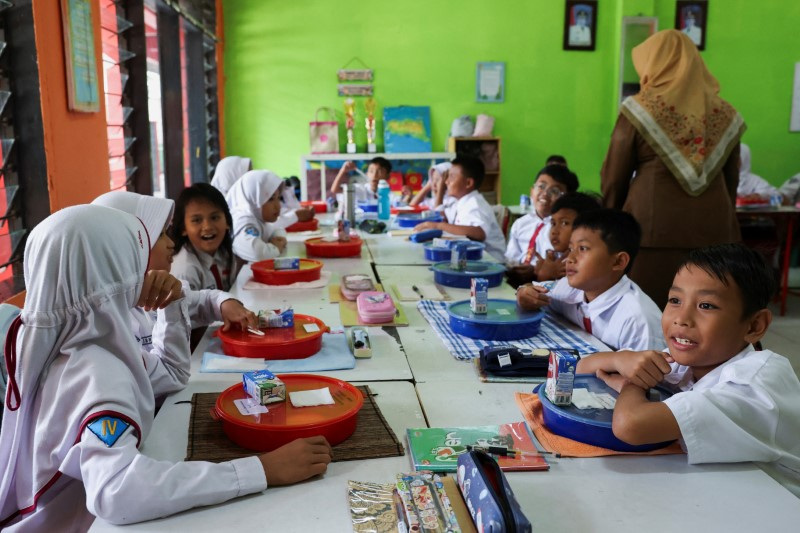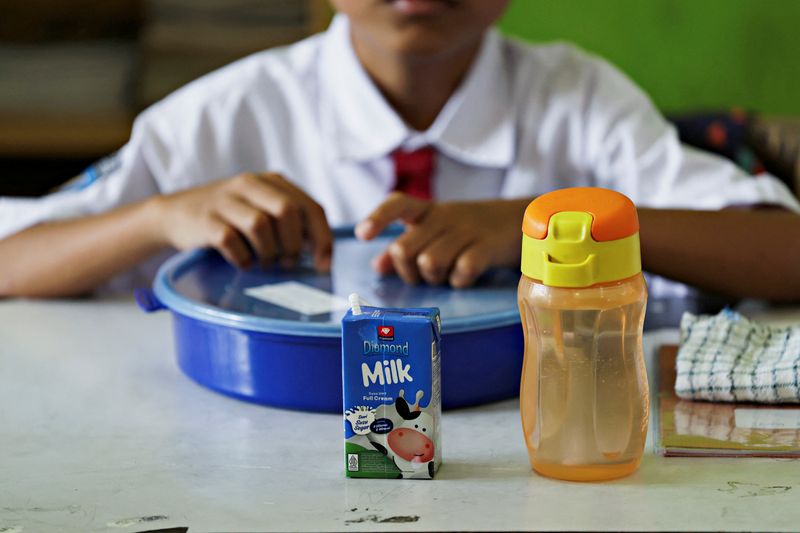By Dewi Kurniawati
JAKARTA (Reuters) - Indonesia's president-elect campaigned on a pledge to provide free meals to over 80 million school children, a costly and daunting logistical effort that is poised to lift dairy imports and ultimately boost the country's underdeveloped milk industry.
The programme, budgeted at $28 billion when fully implemented, aims to improve nutrition in a country where the share of caloric intake from grains is high, milk consumption is low and 21.5% of children under five are stunted.
Prabowo Subianto, who takes office in October after winning the presidential election in February, has also called for Indonesia to be self-sufficient in food but the country is a major importer of wheat, rice, soybeans, beef and dairy.
Indonesia's agriculture ministry has said the lunch programme, which also includes free meals for expectant mothers, will require 4.1 million tons of milk. The U.S. Department of Agriculture (USDA) expects Indonesia to consume 4 million tons of milk this year.
Just 16% of dairy demand in the country is met with domestic fresh milk supply.
That means Indonesia will need to significantly ratchet up imports of dairy products including powdered milk from suppliers such as New Zealand and live cattle from Australia, a potential boon amid sluggish Chinese demand.
"With 83 million kids and pregnant mothers in Indonesia, the opportunity is enormous," said Charlie McElhone, general manager of sustainable dairy at industry service body Dairy Australia, which he said is speaking with Indonesian counterparts and the Australian government about potential opportunities.
"Nothing is etched in stone at the moment. We are waiting for Prabowo to give more clarity once he comes into office," he said.
Indonesia's annual per capita milk consumption is 16.27 kg, lagging Southeast Asian neighbours such as Thailand and Vietnam at roughly 26 kg and far below the global average of about 100 kg, according to the UN Food and Agriculture Organization (FAO), the result of limited land availability, the high cost of raising dairy cattle and small-scale ownership. A 2022 foot and mouth disease outbreak slashed domestic production.
Prabowo has for more than a decade called for a "White Revolution" of expanded milk consumption. During his campaign, he said Indonesia needs to import 1.5 million head of dairy cattle to grow the industry and cut imports.
That would be a drastic increase from a herd among dairy cooperatives and modern dairy farms estimated by the USDA at just under 260,000 head at the end of 2023. Such imports could take more than a decade and cost billions of dollars.
New Zealand is the top supplier of milk to Indonesia, exporting almost NZ$1 billion ($600 million) of dairy products to the country in 2023, followed by the European Union.
"We're yet to see the full details of the school lunch programme, nonetheless the inclusion of milk in the proposed programme is an endorsement of the nutritional value of dairy," said James Robertson, trade strategy manager at New Zealand's Fonterra Co-operative Group.
EXPORTING CATTLE
Dairy Australia's McElhone said exporting heifers is complex, including infrastructure and supply chains, and animal welfare must be considered.
Australia, the only country approved as a source for dairy cattle by Indonesia, used to export 100,000 heifers a year, mostly to China, but now ships about half that many, he said.
"The local consumption provided by this programme will eventually build Indonesia's local capacity to provide its population with milk and dairy products," said George Marantika, chair of the Australia-New Zealand committee at the Indonesia chamber of commerce.
For the rest of the menu in the meals programme, Prabowo's advisers say authorities will prioritise local sources to limit imports and manage costs.
Still, the programme is expected to spur demand for protein, said I Dewa Made Agung, executive director of the Indonesia Food Security Review (IFSR), a think tank running a pilot project for Prabowo's meals programme.
This could drive imports. Previously, rising consumption of chicken and eggs has spurred increased wheat imports for poultry feed.
The average Indonesian diet has one of the highest shares of energy intake from grains, especially rice, with the proportion of non-starchy food at 30%, below the global average of 50%, according to the FAO.
Consumption of vegetables, fruit, meat and fat is low, it said.
While experts said giving healthy food to school-age children is too late to fight stunting, Prabowo said improving nutrition is key to bolstering health and long term growth in Southeast Asia's biggest economy.
Indonesia's geography - the country is spread across thousands of islands - poses logistical challenges, and the free meals project may use centralised kitchens or buy food from existing local small and medium businesses, cooperatives, and local suppliers, with tradeoffs in terms food quality, costs and procurement, IFSR's Dewa said.
For now, Prabowo's advisers envision school meals based on local ingredients, such as fish in coastal areas or boars and yams in mountainous areas of Papua, said Ahmed Zaki Iskandar, an economics affairs ministry official advising Prabowo's meals team.
"We have advised to prioritise underdeveloped, frontier and remote areas, where nutrition intake is bad and stunting level is high," Zaki said.

In the first stage of the programme, Zaki said, he is advising that milk distribution be limited to a few times a week due to inadequate domestic supply.
($1 = 1.6669 New Zealand dollars)
